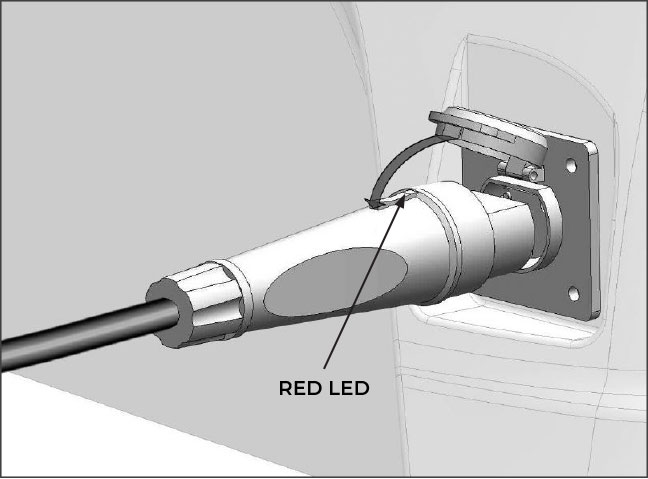The charger should stay connected to the AC outlet until the charge cycle is complete. To plug in the charger, lift the receptacle cover and hold it in place while lining up and inserting the wand. Once lined up properly, push the charger wand into place until the cover engages the lock tab on top of the wand. Once a connection is made, the meter will register the status. When the cycle is complete and the vehicle is completely charged, it will shut off automatically to prevent over-charging of the system. Remove the charging handle from the vehicle prior to operation. Make sure the receptacle cover is locked in on the step of the plug to ensure a secure connection. The LED on the connector will always be RED, which indicates the AC power outlet is working. Your battery can be safely charged with the key in the OFF position.

The top cover of each battery has a QR code to install the Smart Battery app, allowing you to view your battery’s charge status, for added peace of mind. Your battery features a sleep mode, that will turn the power off after 1 hour of the key power being supplied without driving. If this happens, cycle your vehicle’s key off and back on, to restart your battery. On the 80Ah, 105Ah, and 160Ah batteries you will have to press the power button on the passenger side of the vehicle.
Your lithium battery requires very little maintenance. To clean the battery, wipe it down with a damp cloth. DO NOT spray down or immerse the battery with water.
Yearly – use a 13 mm wrench or socket to check the main battery terminal bolts for tightness. The main terminal bolt torque should be 124 in-lb.
Every Six Months – You will see a 4-pin connector, located near your battery. Unplug this connector and inspect it for corrosion every six months.
For STAR Lithium Batteries, fully charge and then turn the battery off. Avoid locations where freezing temperature is expected. Keeping a battery at a high state of charge will also prevent freezing. Also avoid direct exposure to heat sources, such as radiators or space heaters. Temperatures above 80°F accelerate the battery’s self-discharge characteristics.
For storage over one month, turn OFF the devices connected to the battery and push OUT the battery push button (if applicable) place the battery in a dry and ventilated location with a temperature between 0˜30C° (32˜86F°)
Do not store the battery near corrosive material, fire, or heat sources.
- We strongly recommended that your Lithium battery is recharged after each use.
- Charge the battery as soon as possible when the state of charge is less than 10%.
- Always avoid discharging the battery to a state of charge that is less than 5%.
- Even if not being used, fully recharge the battery at least once every 3 months.
- Fully charge the battery before leaving it for more than 30 day period of time.
- Avoid accelerating harshly as it may cause current spikes, triggering the battery’s self-protective cut-off.
From full charge to discharge, STAR-smart lithium batteries deliver higher peak power for improved speed and acceleration. You get full power for longer drive distance with no sacrifice in vehicle performance.

The actual distance you can travel in an electric vehicle is determined by the load you put on the electric motor. Larger and heavier cars will use more energy. Lifted vehicles will use more energy because of the additional weight and larger tires. Adding passengers and uneven terrain will increase the load on the motor. The opposite is true as well. If you lighten the load on the vehicle it will travel farther. The following ranges are based on a 2-passenger vehicle traveling on flat ground.